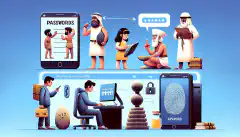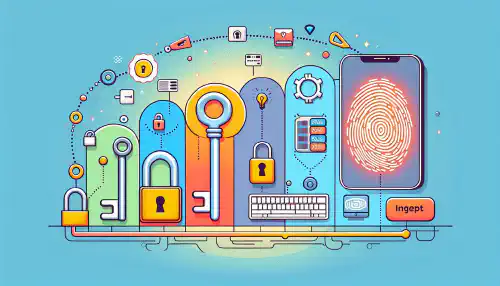Unveiling the Password Revolution: From Ancient Seals to Biometric Authentication

Table of Contents
The Evolution of Passwords: From Creation to Management
Passwords have been used for centuries as a way to authenticate and protect sensitive information. Over time, passwords have evolved from simple methods of authentication to complex systems that involve various security measures. In this article, we will explore the history of passwords, common password creation practices, password management techniques, emerging trends in password security, and the future of passwords. By understanding the evolution of passwords, we can better understand the challenges and opportunities in password security.
Key Takeaways
- Passwords have evolved from ancient methods of authentication to complex systems involving multiple security measures.
- Choosing strong passwords and using password generation tools are essential for creating secure passwords.
- Password managers and two-factor authentication are effective techniques for managing passwords.
- Emerging trends in password security include passwordless authentication and behavioral biometrics.
- The future of passwords may involve a post-password era and advancements in authentication using machine learning.
The History of Passwords
Ancient Methods of Authentication
In the early days of authentication, passwords as we know them today did not exist. Instead, ancient civilizations used various methods to verify the identity of individuals. These methods included physical tokens, such as seals or badges, which were used to grant access to restricted areas. Additionally, some societies relied on knowledge-based authentication, where individuals had to provide specific information or answer questions to prove their identity.
The Birth of Passwords
In the early days of computer systems, the concept of passwords emerged as a means of securing access to sensitive information. Passwords provided a layer of protection against unauthorized access and were initially used to authenticate users. However, the early password systems were relatively simple and lacked the complexity and security measures we have today.
Early Password Security Measures
In the early days of password security, verification was a key concern. Passwords were often stored in plaintext, making them vulnerable to unauthorized access. To address this issue, encryption techniques were introduced to protect passwords during storage and transmission. One common method was the use of hashing algorithms, which converted passwords into a fixed-length string of characters. This hash value was then stored in the system instead of the actual password. When a user entered their password, it was hashed and compared to the stored hash value for verification. This approach added an extra layer of security by preventing the exposure of actual passwords.
Common Password Creation Practices

Choosing Strong Passwords
Creating a strong password is crucial for protecting your online accounts from unauthorized access. Strong passwords are typically long, complex, and unique to each account. Here are some key considerations when choosing a strong password:
- Length: Longer passwords are generally more secure as they are harder to guess or crack. Aim for a minimum of 12 characters.
- Complexity: Include a combination of uppercase and lowercase letters, numbers, and special characters to increase the complexity of your password.
- Uniqueness: Avoid using the same password for multiple accounts. If one account is compromised, it could potentially lead to unauthorized access to other accounts.
It’s important to note that while strong passwords provide a higher level of security, they can also be more difficult to remember. Consider using a password manager to securely store and manage your passwords. A password manager can generate and store complex passwords for you, eliminating the need to remember them.
Tip: Avoid using easily guessable information such as your name, birthdate, or common words as part of your password. These can be easily cracked using automated tools.
The Role of Complexity
In password security, complexity plays a crucial role in ensuring the strength and effectiveness of passwords. Complex passwords are harder for attackers to guess or crack, making them an essential component of a robust security strategy . Here are some key points to consider when it comes to the role of complexity in password creation and management:
Password Length and Strength
The length and strength of a password play a crucial role in its security. Longer passwords are generally more secure as they provide a larger search space for potential attackers to guess. It is recommended to use passwords that are at least 12 characters long. Additionally, the use of a combination of uppercase and lowercase letters, numbers, and special characters further enhances the strength of a password.
- Longer passwords provide a larger search space for attackers
- Use a combination of uppercase and lowercase letters, numbers, and special characters
- Recommended password length is at least 12 characters
It is important to note that password complexity alone is not sufficient to ensure security. Users should also avoid using easily guessable information such as personal names, birthdays, or dictionary words as part of their passwords. Implementing passphrases instead of traditional passwords can also be an effective strategy. Passphrases are longer phrases or sentences that are easier to remember but harder to crack.
- Avoid using personal names, birthdays, or dictionary words
- Consider using passphrases instead of traditional passwords
Tip: Regularly updating passwords and avoiding password reuse across multiple accounts can significantly reduce the risk of unauthorized access.
Password Generation Tools
Password generation tools are software programs or online services that help users create strong and secure passwords. These tools are designed to generate passwords that are difficult for hackers to guess or crack. They often incorporate a combination of random characters, numbers, and symbols to enhance password strength. Randomness is a key factor in password generation tools as it ensures that the passwords generated are unique and not easily predictable.
Password generation tools offer several advantages for users:
- They save time and effort by automatically generating complex passwords.
- They eliminate the need for users to come up with their own passwords, reducing the risk of using weak or easily guessable passwords.
- They can generate passwords of varying lengths, allowing users to choose a password that meets the specific requirements of different websites or systems.
It is important to note that while password generation tools can be helpful, users should still exercise caution and follow best practices for password security. This includes regularly updating passwords, avoiding reuse of passwords across multiple accounts, and enabling additional security measures such as two-factor authentication.
Password Management Techniques

Password Managers
Password managers are tools that help users securely store and manage their passwords. They provide a convenient way to generate strong, unique passwords for each online account, eliminating the need for users to remember multiple complex passwords. By centralizing password storage, password managers reduce the risk of password reuse and make it easier to maintain good password hygiene.
Password managers offer several key features that enhance password security:
- Encryption: Passwords stored in password managers are encrypted, ensuring that even if the password manager is compromised, the stored passwords remain protected.
- Auto-fill: Password managers can automatically fill in login credentials, reducing the risk of phishing attacks by ensuring users enter their passwords on legitimate websites.
- Password strength analysis: Some password managers provide a password strength analysis feature, which evaluates the strength of existing passwords and suggests improvements.
Using a password manager can greatly improve password security and reduce the risk of password-related attacks. However, it is important to choose a reputable password manager and follow best practices for securing the password manager itself, such as using a strong master password and enabling two-factor authentication.
Two-Factor Authentication
Two-Factor Authentication (2FA) is a security measure that adds an extra layer of protection to user accounts. It requires users to provide two different types of identification before granting access to their accounts. This method significantly enhances security by combining something the user knows (such as a password) with something the user possesses (such as a physical token or a mobile device).
Implementing 2FA offers several benefits:
- Increased Security: By requiring an additional form of authentication, 2FA reduces the risk of unauthorized access to user accounts.
- Protection Against Password Theft: Even if a user’s password is compromised, an attacker would still need the second factor of authentication to gain access.
- Mitigation of Credential Stuffing Attacks: 2FA can help prevent automated attacks that use stolen credentials by requiring an additional verification step.
To implement 2FA, organizations can use various methods, including:
- One-Time Passwords (OTP): Users receive a unique code on their mobile device or email, which they enter along with their password.
- Biometric Authentication: Users can authenticate using their fingerprint, face recognition, or voice recognition.
- Hardware Tokens: Users carry a physical device that generates a unique code for authentication.
It is important to note that while 2FA significantly improves security, it is not foolproof. Attackers can still exploit vulnerabilities in the implementation or trick users into providing both factors of authentication. Therefore, organizations should continuously educate users about the importance of 2FA and the potential risks associated with bypassing or disabling it.
Biometric Authentication
Biometric authentication is a cutting-edge method of verifying a user’s identity based on unique physical or behavioral characteristics. It offers a higher level of security compared to traditional password-based authentication methods. By relying on biological traits such as fingerprints, iris patterns, or facial recognition, biometric authentication provides a more reliable and difficult-to-replicate form of identification. This technology has gained significant traction in recent years, with many organizations adopting it as a front-line defense against unauthorized access .
Password Expiration Policies
Password expiration policies are a commonly used security measure in many organizations. These policies require users to change their passwords at regular intervals, typically every 30, 60, or 90 days. The rationale behind password expiration is to reduce the risk of compromised passwords by ensuring that passwords are regularly updated.
However, there is ongoing debate among cybersecurity experts regarding the effectiveness of password expiration policies. Some argue that frequent password changes can lead to weaker passwords, as users may resort to using easily guessable passwords or writing them down. Others argue that modern password cracking techniques can render password expiration policies less effective.
Despite the debate, password expiration policies can still be beneficial when implemented correctly. Here are some key considerations for organizations implementing password expiration policies:
- Password complexity requirements: Passwords should be required to meet certain complexity criteria, such as a minimum length, a combination of uppercase and lowercase letters, numbers, and special characters.
- User education and awareness: Organizations should provide training and resources to educate users about the importance of strong passwords and the risks associated with weak passwords.
- Multi-factor authentication: Implementing multi-factor authentication can provide an additional layer of security, reducing the reliance on password expiration policies.
- Regular security assessments: Organizations should regularly assess their password security measures to identify any vulnerabilities or weaknesses.
In conclusion, password expiration policies can be a useful tool in maintaining password security, but they should be implemented alongside other security measures and with careful consideration of their potential drawbacks.
Password Recovery Methods
As a cybersecurity expert, I understand the importance of having reliable password recovery methods in place. In the event that users forget their passwords or are locked out of their accounts, these methods provide a way to regain access while maintaining the security of the system. Here are some common password recovery methods:
Security Questions: Many online platforms use security questions as a way to verify the identity of users during the password recovery process. Users are prompted to answer questions that they previously set up, such as their mother’s maiden name or the name of their first pet.
Email Verification: Another common method is to send a password reset link to the user’s registered email address. This link allows the user to create a new password and regain access to their account.
Two-Factor Authentication: Some platforms require users to provide a second form of authentication, such as a code sent to their mobile device, in addition to their password. This adds an extra layer of security to the password recovery process.
It is important for organizations to implement robust password recovery methods to ensure that users can regain access to their accounts securely. By combining multiple methods and verifying the user’s identity through different channels, the risk of unauthorized access can be minimized.
Emerging Trends in Password Security

Passwordless Authentication
Passwordless authentication is an emerging trend in password security that aims to eliminate the need for traditional passwords. This approach leverages alternative methods of authentication, such as biometrics or hardware tokens, to verify a user’s identity. By removing the reliance on passwords, organizations can enhance security and user experience. Workplace security is a critical concern for businesses, and passwordless authentication offers several advantages in this context.
Multi-Factor Authentication
Multi-Factor Authentication (MFA) is a crucial security measure that adds an extra layer of protection to user accounts. It requires users to provide multiple forms of identification before granting access. MFA significantly reduces the risk of unauthorized access and strengthens the overall security posture.
Benefits of Multi-Factor Authentication:
Enhanced Security: By combining multiple factors, such as something the user knows (password), something the user has (smartphone), and something the user is (biometric data), MFA provides a higher level of security compared to traditional password-based authentication.
Protection Against Credential Theft: MFA mitigates the risk of credential theft, as even if an attacker manages to obtain a user’s password, they would still need the additional factors to gain access.
Reduced Dependency on Passwords: MFA reduces the reliance on passwords as the sole means of authentication, addressing the limitations of password-based security.
Tip: When implementing MFA, it is important to choose factors that are both secure and convenient for users.
Common Factors Used in MFA:
- One-Time Passwords (OTP): Time-based or event-based codes generated by an authentication app or sent via SMS.
- Biometrics: Unique physical or behavioral characteristics, such as fingerprints or facial recognition.
- Hardware Tokens: Physical devices that generate one-time passwords or provide cryptographic keys.
- Smartphone Apps: Authenticator apps that generate time-based codes or use push notifications for approval.
- Email or Phone Verification: Sending a verification code to the user’s email or phone number.
MFA is an effective security measure that organizations should consider implementing to protect sensitive data and prevent unauthorized access.
Behavioral Biometrics
Behavioral biometrics is a cutting-edge authentication method that analyzes unique patterns of human behavior to verify user identity. Unlike traditional authentication methods that rely on passwords or biometric data, such as fingerprints or facial recognition, behavioral biometrics focuses on how users interact with devices and systems. By analyzing factors like typing speed, mouse movements, and touchscreen gestures, behavioral biometrics can create a unique user profile that can be used to authenticate individuals.
Blockchain and Password Security
Blockchain technology has emerged as a promising solution for enhancing password security. By leveraging the decentralized and immutable nature of blockchain, it offers a robust framework for storing and managing passwords. Biometric identification is one of the key areas where blockchain can play a significant role. With the increasing popularity of biometric authentication methods such as fingerprint scanning and facial recognition, integrating biometric data with blockchain can provide an added layer of security.
Artificial Intelligence in Password Protection
Artificial Intelligence (AI) is revolutionizing the field of password protection. With its ability to analyze vast amounts of data and identify patterns, AI has the potential to greatly enhance password security.
AI-powered password protection systems can detect and prevent various types of attacks, such as brute force attacks and dictionary attacks. By continuously learning from user behavior and analyzing login attempts, AI algorithms can identify suspicious patterns and flag them for further investigation.
Additionally, AI can help in the creation of stronger passwords. By analyzing common password patterns and known vulnerabilities, AI algorithms can generate password recommendations that are both secure and easy to remember.
AI can also play a role in password recovery methods. By analyzing user behavior and historical data, AI algorithms can accurately determine whether a password reset request is legitimate or potentially fraudulent.
In summary, AI has the potential to revolutionize password protection by enhancing security measures, improving password creation practices, and streamlining password recovery methods.
The Future of Passwords

Post-Password Era
In the post-password era, traditional password-based authentication methods are being replaced by more advanced and secure alternatives. This shift is driven by the increasing number of data breaches and the realization that passwords alone are no longer sufficient to protect sensitive information. Biometric authentication is emerging as a popular alternative, using unique physical or behavioral characteristics such as fingerprints, facial recognition, or voice recognition to verify a user’s identity. This method provides a higher level of security as it is difficult to replicate or steal someone’s biometric data.
Another trend in the post-password era is the use of multi-factor authentication (MFA). MFA combines two or more authentication factors, such as something the user knows (password), something the user has (smartphone), or something the user is (biometric data), to verify identity. This adds an extra layer of security and makes it more difficult for attackers to gain unauthorized access.
To further enhance security, behavioral biometrics is being explored as a means of authentication. This technique analyzes patterns of behavior, such as typing speed, mouse movements, or touchscreen gestures, to verify the user’s identity. By continuously monitoring these behavioral patterns, any anomalies can be detected and flagged as potential security threats.
Blockchain technology is also being leveraged to improve password security in the post-password era. By decentralizing password storage and authentication processes, blockchain eliminates the need for a centralized authority, reducing the risk of data breaches and unauthorized access. Additionally, artificial intelligence (AI) is playing a significant role in password protection. AI algorithms can analyze user behavior, detect patterns, and identify potential security risks, allowing for proactive measures to be taken to prevent unauthorized access.
As we move towards a post-password era, there are both challenges and opportunities. One of the challenges is ensuring widespread adoption of new authentication methods and technologies. Education and awareness about the importance of strong authentication practices are crucial to overcome resistance to change. On the other hand, the post-password era presents opportunities for innovation and advancements in authentication. With the continuous evolution of technology, we can expect to see new and more secure authentication methods that provide convenience without compromising security.
Passwordless Society
In a passwordless society, traditional password-based authentication methods are replaced with alternative forms of authentication. This shift is driven by the need for stronger security measures and the desire for a more convenient user experience. Memorize is no longer a requirement as users no longer need to remember complex passwords. Instead, authentication is based on other factors such as biometrics or behavioral patterns. This eliminates the risk of weak passwords or password reuse, which are common security vulnerabilities.
Advancements in Authentication
Advancements in authentication have revolutionized the way we secure our digital identities. With the increasing sophistication of cyber threats, traditional password-based authentication methods have become vulnerable. As a result, new authentication techniques have emerged to provide stronger security and better user experience.
One such advancement is the use of biometric authentication. Biometric authentication utilizes unique physical or behavioral characteristics, such as fingerprints, facial recognition, or voice patterns, to verify a user’s identity. This method offers a higher level of security as biometric features are difficult to replicate or forge.
Another significant advancement is the adoption of two-factor authentication (2FA). With 2FA, users are required to provide two different types of credentials to access their accounts, typically a combination of something they know (e.g., a password) and something they have (e.g., a unique code sent to their mobile device). This adds an extra layer of security, as even if one factor is compromised, the attacker would still need the second factor to gain access.
To further enhance security, organizations are implementing behavioral biometrics. This technique analyzes user behavior patterns, such as typing speed, mouse movements, and touchscreen gestures, to create a unique user profile. By continuously monitoring these behavioral traits, organizations can detect anomalies and potential unauthorized access attempts.
In addition to these advancements, the integration of blockchain technology has also shown promise in password security. Blockchain provides a decentralized and tamper-proof ledger that can be used to store and verify user credentials. This eliminates the need for a central authority and reduces the risk of data breaches.
As technology continues to evolve, the role of artificial intelligence (AI) in password protection is becoming increasingly important. AI algorithms can analyze vast amounts of data to detect patterns and anomalies, enabling more accurate identification of potential threats. AI-powered systems can also adapt and learn from user behavior, improving the overall security and user experience.
While advancements in authentication offer improved security, it is essential to consider the challenges and opportunities they present. Organizations must carefully balance security measures with user convenience and privacy concerns. Additionally, ongoing research and development are crucial to stay ahead of evolving cyber threats and ensure the effectiveness of authentication methods in the future.
The Role of Machine Learning
Machine learning plays a crucial role in password security and authentication systems. With the increasing complexity and sophistication of cyber threats, traditional password-based authentication methods are no longer sufficient. Machine learning algorithms can analyze large amounts of data and identify patterns and anomalies that may indicate unauthorized access attempts or suspicious behavior. By leveraging machine learning, organizations can enhance their password security measures and protect sensitive information.
Machine learning can be used to:
Detect and prevent brute-force attacks: Machine learning algorithms can analyze login attempts and detect patterns that indicate a brute-force attack. By identifying multiple failed login attempts from the same IP address or unusual login patterns, machine learning can help prevent unauthorized access.
Identify and mitigate account takeover: Machine learning algorithms can analyze user behavior and identify unusual activity that may indicate an account takeover. By detecting changes in login patterns, device usage, or IP addresses, machine learning can help prevent unauthorized access to user accounts.
Improve password strength evaluation: Machine learning algorithms can analyze password patterns and evaluate the strength of passwords. By identifying common password patterns or easily guessable passwords, machine learning can provide recommendations for stronger passwords.
Machine learning is a powerful tool in the fight against cyber threats and can significantly enhance password security and authentication systems. By leveraging machine learning algorithms, organizations can stay one step ahead of attackers and protect their sensitive information.
Challenges and Opportunities
As the field of cybersecurity continues to evolve, new challenges and opportunities arise in the realm of password security. These challenges stem from the increasing sophistication of cyber attacks and the constant need to stay one step ahead of malicious actors. At the same time, advancements in technology present exciting opportunities for enhancing password security and improving user experience.
1. Password Cracking Techniques: Cybercriminals employ various techniques to crack passwords, including brute force attacks, dictionary attacks, and rainbow table attacks. These methods exploit weaknesses in password creation practices and highlight the importance of choosing strong, complex passwords.
2. User Education and Awareness: One of the ongoing challenges in password security is ensuring that users are educated about best practices and are aware of the risks associated with weak passwords. Organizations must invest in user training programs to promote password hygiene and encourage the adoption of secure password management techniques.
3. Password Fatigue: With the increasing number of online accounts and services that require passwords, users often experience password fatigue. This can lead to poor password management practices, such as reusing passwords across multiple accounts or using weak passwords. Password managers and passwordless authentication methods can help alleviate this challenge.
4. Balancing Security and Usability: Striking the right balance between strong password security and user convenience is an ongoing challenge. Complex password requirements and frequent password changes can frustrate users and lead to insecure practices, while lax security measures can compromise sensitive data. Organizations must find ways to implement robust security measures without sacrificing usability.
5. Emerging Technologies: The rapid advancement of technologies such as biometrics, blockchain, and artificial intelligence presents opportunities for improving password security. Biometric authentication methods, such as fingerprint or facial recognition, offer a more secure and convenient alternative to traditional passwords. Blockchain technology can enhance password security by decentralizing authentication processes, while artificial intelligence can help detect and prevent password-related threats.
In conclusion, the challenges and opportunities in password security require a multi-faceted approach that combines user education, technological advancements, and a focus on balancing security and usability. By addressing these challenges and leveraging emerging technologies, organizations can strengthen their password security practices and better protect sensitive information.
The future of passwords is rapidly evolving as technology advances and cyber threats become more sophisticated. With the rise of biometric authentication, such as fingerprint and facial recognition, traditional passwords may soon become a thing of the past. Additionally, the use of multi-factor authentication, where users are required to provide multiple forms of identification, adds an extra layer of security. As we move towards a passwordless future , it is crucial to stay informed about the latest trends and best practices in cybersecurity. Visit simeononsecurity.com to discover expert security insights and resources to help you stay ahead in the ever-changing world of cybersecurity.
Conclusion
In conclusion, the evolution of passwords has been a fascinating journey from ancient methods of authentication to the emerging trends in password security. The history of passwords reveals the gradual shift from simple authentication techniques to the birth of passwords as a means of securing access. Early password security measures were implemented to enhance the protection of sensitive information.
As technology advanced, common password creation practices evolved to include choosing strong passwords with a combination of complexity, length, and strength. Password generation tools and security questions became popular methods for creating secure passwords.
Password management techniques such as password managers, two-factor authentication, and biometric authentication have significantly improved the security of passwords. Password expiration policies and recovery methods have also played a crucial role in maintaining password security.
Emerging trends in password security, such as passwordless authentication, multi-factor authentication, behavioral biometrics, blockchain, and artificial intelligence, are shaping the future of password protection. These advancements offer promising solutions to the challenges faced in password security.
Looking ahead, the future of passwords holds the potential for a post-password era and a passwordless society. Advancements in authentication, including the role of machine learning, will continue to drive innovation in password security. However, challenges and opportunities lie ahead as hackers become more sophisticated in their techniques. It is essential for individuals and organizations to stay vigilant and adapt to the changing landscape of password security. The evolution of passwords is an ongoing process that requires continuous improvement and adaptation to ensure the protection of sensitive information.
Frequently Asked Questions
What is the history of passwords?
Passwords have been used for authentication since ancient times, with early methods including secret codes and symbols.
How do I choose a strong password?
A strong password should be long, unique, and include a combination of letters, numbers, and special characters.
Are password managers safe to use?
Yes, password managers can enhance security by generating and storing complex passwords, as long as you choose a reputable and secure password manager.
What is two-factor authentication?
Two-factor authentication adds an extra layer of security by requiring users to provide two different types of authentication, such as a password and a unique code sent to their mobile device.
How does biometric authentication work?
Biometric authentication uses unique physical or behavioral characteristics, such as fingerprints or facial recognition, to verify a user’s identity.
What are the benefits of passwordless authentication?
Passwordless authentication eliminates the need for traditional passwords, reducing the risk of password-related attacks and simplifying the user experience.






